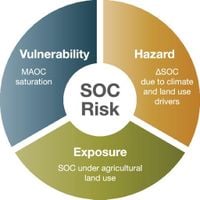As the European Union seeks to become climate neutral by 2050, new research shines a light on the role of agricultural soils in carbon sequestration and the risks posed to soil organic carbon (SOC) levels.
A recent study has revealed that soil organic carbon is essential for storing carbon dioxide (CO2) from the atmosphere, thereby mitigating climate change. However, this latest investigation also highlights the vulnerability of agricultural soils, with findings indicating that up to 83 million hectares are at high risk of SOC loss across Europe. Researchers have proposed a novel Soil Organic Carbon Risk Index to better inform agricultural practices and policy.
The research, conducted by a collaborative team of scientists across various European research institutions, examined the distribution of particulate organic carbon (POC) and mineral-associated organic carbon (MAOC) from 2009 to 2018. This period was marked by a significant estimated loss of 0.75% in SOC from agricultural soils, which has substantial implications for climate change mitigation efforts, especially given that EU agricultural soils are below their SOC saturation levels.
Using data from the Land Use and Land Cover Survey (LUCAS) and advanced spectroscopic techniques, researchers identified significant patterns in SOC changes influenced by environmental variations and management practices. They utilized a k-means clustering approach to categorize soils into sixteen pedo-climatic zones, based on parameters such as aridity, net primary productivity, soil pH, and land form.
The scientists found that the relationship between POC and MAOC differs significantly across these zones, challenging previous assumptions about soil mineral capacity for SOC storage. Instead of a universal mineralogical capacity, they identified an effective MAOC capacity which fluctuates between regional ecosystems.
“Our findings indicate that effective MAOC capacity, which varies according to specific environmental conditions, is a crucial aspect for effective carbon management in soils,” wrote the authors of the study. They emphasized the importance of mindful agricultural practices that consider these regional differences to better preserve and increase SOC levels.
In assessing the risk faced by agricultural lands, the research introduced the SOC risk index. This index combines the observed changes in SOC with the effective MAOC capacities, thereby providing a more comprehensive view of soil carbon health. Vulnerability is assessed through the degree of MAOC saturation, with areas classified as high hazard and high risk when their MAOC saturation is above the median while experiencing negative SOC changes. The results show that high hazard and high-risk areas, covering 43 to 83 million hectares, are primarily concentrated in the cooler, humid regions of Europe.
A well-defined SOC management strategy is essential to enhancing carbon sequestration and mitigating climate change impacts. “Our study provides a framework for policymakers and agricultural managers to improve SOC retention and guide sustainable agricultural practices,” stated the team.
Implications of the research extend beyond Europe, signaling an urgent need for tailored soil management practices worldwide that address the diverse climatic and ecological factors impacting agricultural sustainability.
In conclusion, addressing the multifaceted challenges of SOC loss requires a redesign of our agricultural landscape and a commitment to preserving the carbon sequestering abilities of our soils. Policymakers and farmers alike are urged to utilize the insights from this study to develop practices that recover and protect soil organic carbon, thereby contributing to a more sustainable future.




